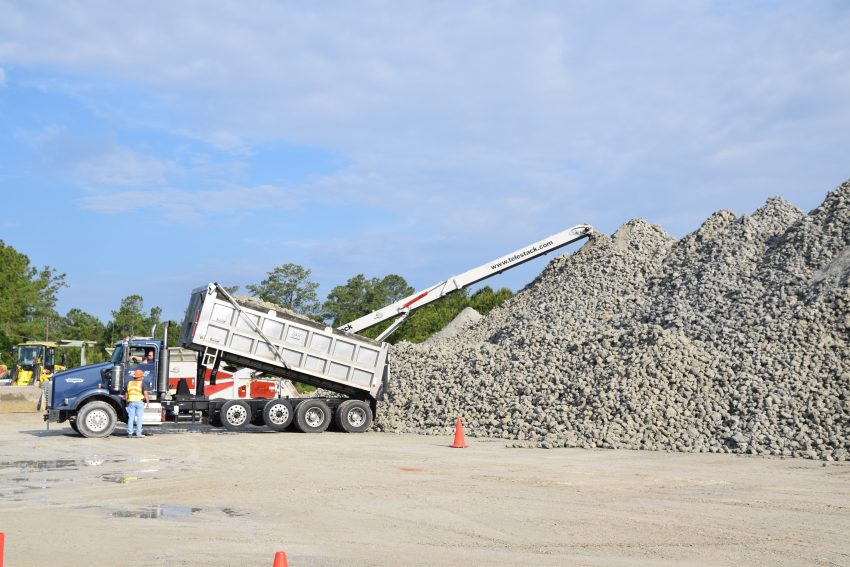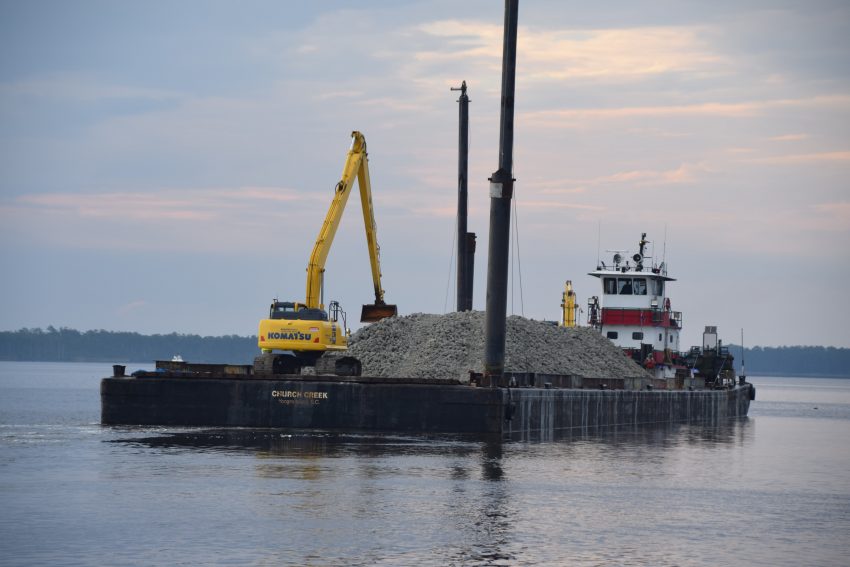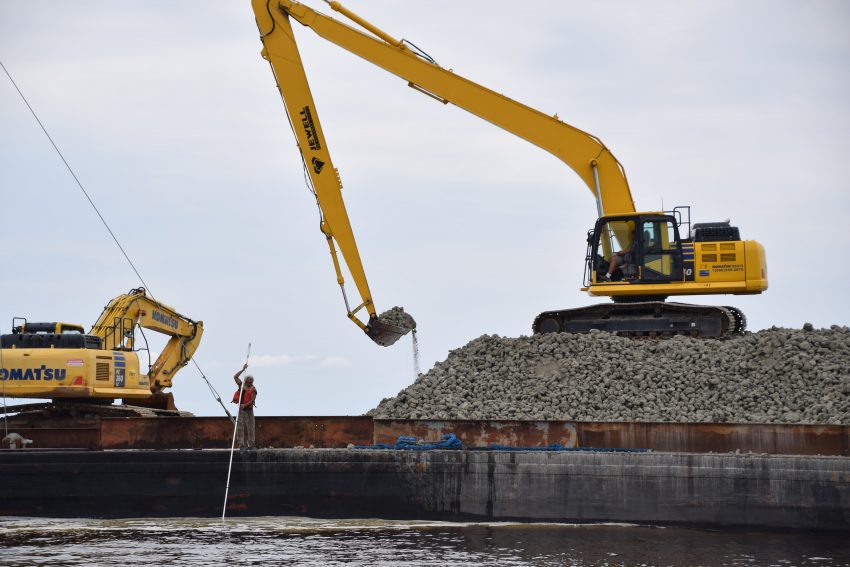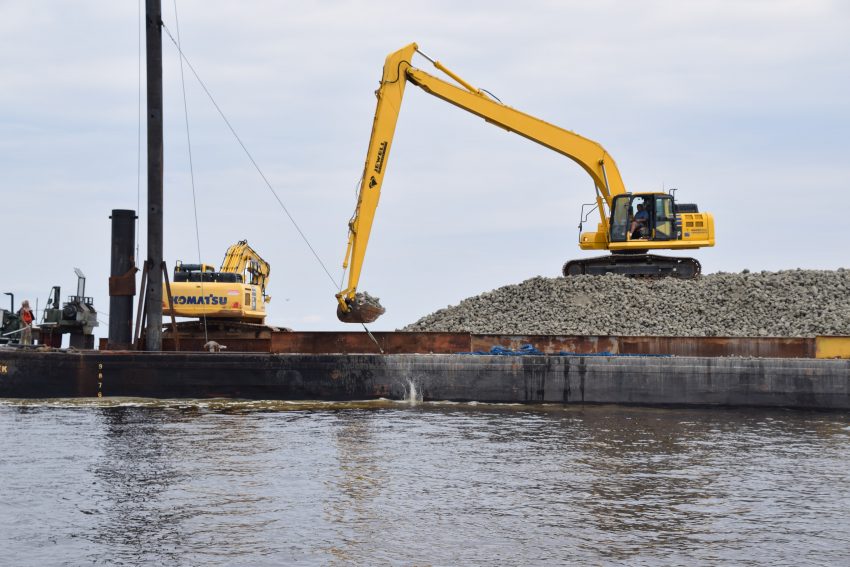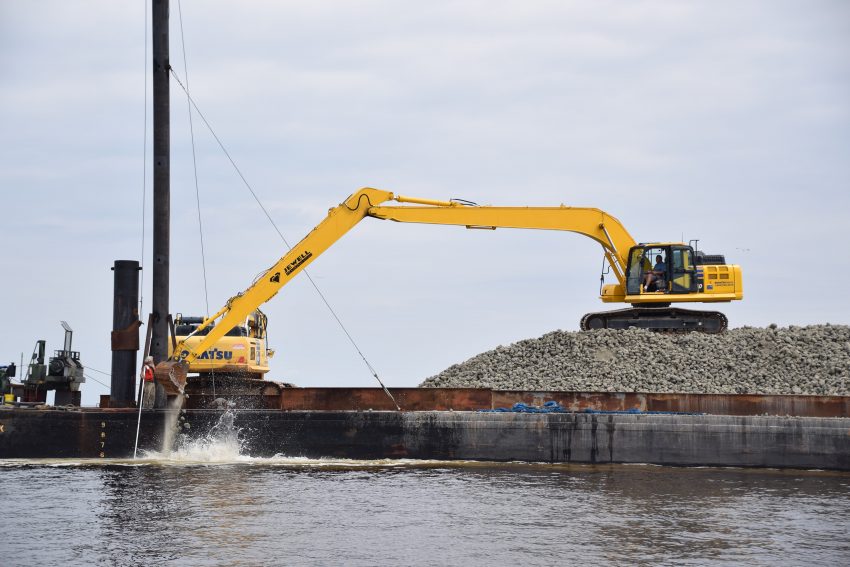CARTERET COUNTY — Crews have started moving about 25,000 tons of limestone marl as construction is underway on the Swan Island Oyster Sanctuary.
“After months of planning and preparation by our staff, as well as by the North Carolina Division of Marine Fisheries and other partners, it’s great to see Stevens Towing breaking ground on the oyster sanctuary,” said Todd Miller, executive director of the North Carolina Coastal Federation.
Construction on the 15-acre sanctuary — which is located in Pamlico Sound near the mouth of the Neuse River — began May 3. It is expected to wrap up in mid-July.
The Division of Marine Fisheries (DMF) stockpiled the limestone marl, which it purchased from a North Carolina quarry, at its South River facility. It took about 1,200 tractor trailer loads to bring all of the material to the stockpile location.
Stevens Towing Company, Inc., which has an office in Edenton, started moving the limestone marl out to the sanctuary site on a 250-foot barge that holds about 1,000 tons of material.
DMF staff are on-site during deployments to help with coordination and to make sure the material is at least 6 feet below the surface. The reef ridges are 4 feet high and about 6 to 8 feet wide.
“We’re excited to play a role in this public-private partnership and oyster restoration,” said Jason Peters, artificial reef coordinator for DMF. “To build an oyster sanctuary of this magnitude takes a massive amount of material and detailed logistics.”
Stevens Towing has experience in this work, as it constructed another oyster sanctuary the federation helped plan and design in 2009 with funding from the American Recovery and Reinvestment Act.
This sanctuary project is a public-private partnership, and it is funded through a grant from the National Oceanic and Atmospheric Administration’s (NOAA) community-based habitat restoration program, as well as through matching appropriations from the state General Assembly. Additional funding is provided by Grady White Boats and through donor support.
Oyster sanctuaries provide a place for oysters to repopulate. These 15 acres will not be open to harvest, but nearby cultch planting sites will be. The sanctuary and cultch sites work together to create an interconnected network of oyster reefs, helping improve oyster population numbers and water quality.
“These new reefs will benefit more than oysters — they are also Essential Fish Habitat for at least 26 species of fish,” said Pat Montanio, director of NOAA’s Office of Habitat Conservation. “These reefs will provide highly productive habitat that will benefit commercially and recreationally important fish, including red drum and three species of shrimp.”
The project is the first major installation of the federation’s three-year plan to restore 50 million oysters to North Carolina’s waters. The federation launched the 50 Million Oyster Initiative at the end of 2016 with the goal of restoring 50 acres of oyster sanctuary by 2020. With each acre supporting approximately one million oysters, that will be 50 million oysters back in North Carolina waters, supporting habitat for countless fish and wildlife. And as each oyster is capable of filtering 50 gallons of water per day, those 50 million oysters together will filter 2.5 billion gallons of water per day.
The Swan Island Oyster Sanctuary is part of the Senator Jean Preston Marine Oyster Sanctuary program.
More information on this project and on oysters is available at nccoast.org/oysters and at ncoysters.org.
Learn more about the siting process for oyster sanctuaries.
Click through the photos below to see the materials stockpile at the South River facility and the crew at work on the sanctuary.
- Approximately 18,000 to 19,000 tons of limestone marl are stockpiled at the North Carolina Division of Marine Fisheries’ South River facility. Truckloads of material are still coming in. Photo by Mark Hibbs.
- The barge departs the South River facility on May 3 on its way to the Swan Island Oyster Sanctuary Site in Pamlico Sound. Photo by Mark Hibbs.
- Crew deploy the material from the barge into the sound. Each barge-load holds about 1,000 tons of limestone marl. Photo by Mark Hibbs.
- The limestone marl is used to create ridges that are about 4 feet high and 6 to 8 feet wide. The ridges must be at least 6 feet below the surface. Photo by Mark Hibbs.
- Construction on the sanctuary is expected to wrap up in mid-July. It takes a day to load the barge and a day to deploy the materials. Weather can also impact whether or not the barge goes out. Photo by Mark Hibbs.

